If these walls could only talk
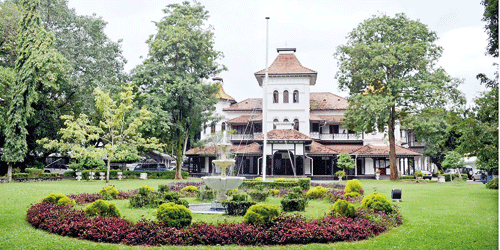
Seat of learning: College House today
Once a mansion of love and loss, College House on Thurstan Road, Colombo 3 is today a motif of expectation to the ‘fresher’ and a symbol of excellence to generations of young men and women whose lives have been shaped by this illustrious institute of learning. The University of Ceylon began in 1942 at College House.
College House however began life as ‘Regina Walauwa’ and therein lies a tale. As the University of Colombo prepares a coffeetable book on 75 years of Sri Lankan University education, there is renewed interest in the history of this stately mansion which was home to one of Colombo’s famed families before it became a seat of learning.
If the streets of Galle could talk, they would testify that no occasion had been merrier than the wedding of Thomas Henry Arthur de Soysa, and his 17-year-old bride Regina Perera. Dubbed as the ‘wedding of the year- 1899’ the nuptials between the fourth son of the philanthropist, Sir Charles Henry de Soysa of Alfred House fame and the only daughter of Simon Perera of Galle’s Closenberg, even made headlines in the London Daily Graphic of March 2, 1899.
The marriage was solemnized at All Saints Church, Fort, Galle and the couple was driven from the church in a coach ‘with six-in-hand, like the Queen’ as Norah Roberts records in her work, ‘Galle as quiet as asleep’. “The men wore toppers and tails. The wedding cake reached from floor to ceiling, ice cream was served for the first time at a Galle wedding. It came off a ship in the harbour,” she wrote.
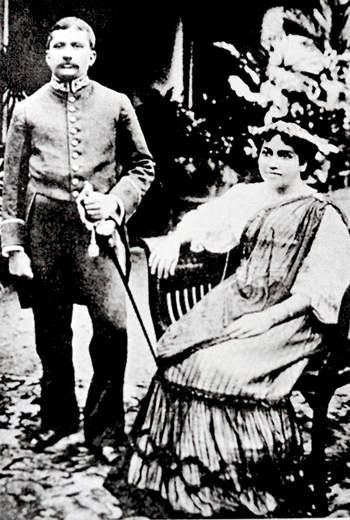
Arthur and Regina de Soysa, seen in a formal portrait. Pix courtesy L.S.D Pieris and Lilamani Goonewardene
With three sons in a row-Francis, Dannister and Titus, Charlotte and Simon Perera of Closenberg in Galle were then blessed with a baby daughter in 1882 whom they named Regina, meaning ‘Queen’. The happiness was short-lived as Charlotte died 12 days after giving birth leaving the young family in mourning. A Mrs. Jansz was engaged to take care of baby Regina. Described as a ‘happy girl with an infectious laugh’ by Norah Roberts in her book, Regina was the apple of her father’s eye, fondly called ‘Gigo-Gigo.’
Simon Perera’s little Regina caught the eye of young Arthur de Soysa. His sister Rita was married to Regina’s eldest brother Francis. Born in 1874 to Sir Charles Henry de Soysa and Lady Catherine de Soysa, Arthur was the fourth son among the 14 children of the couple. The 20th Century Impressions of Ceylon, edited by Arnold Wright, affirms Arthur to be a ‘sole proprietor’ of an export business housed at No. 2, Canal Row, Fort which exported an assortment of produce including coconut oil, citronella oil and mattress fibre, reaching to ‘all parts of the civilized world.’
The affluent merchant and Consul for Chile, Arthur aspired to a life no less than that of a Queen for his young bride and envisaged a ‘home’ named after her – Regina Walauwa on Thurstan Road. The premises were part of his father’s sprawling Alfred House estate. The asymmetrical plan of Regina Walauwa, with its turrets and conical roofs is reminiscent of the Victorian eclecticism of the late 19th-century British architecture, as architect and author Prof. Anoma Pieris, in her book ‘Architecture and Nationalism in Sri Lanka- the trouser under the cloth’ affirms. Prof. Peiris is the great-granddaughter of Arthur and Regina de Soysa.
The building, as the author describes, ‘has few rooms, with numerous verandahs at the front, back and sides of the building, while a rectangular lawn spreads out before its entrance… Plans of one-room depth omitting interior corridors, eccentric elevations with towers or turrets and incorporation of Gothic and Indic architectural features suggested the influence of the British Picturesque Movement and renewed interest in arts and crafts tradition.’ This iconic building of Colombo is also reminiscent of the ‘Travancore Style’ of British architect Robert Chisholm, exemplified in his designs for the Napier Museum in Trivandrum and the Madras Post and Telegraph Office built during the 1870s and 1880s, she writes.
Arthur de Soysa’s regal home mirrored his preference for an ‘Eastern cultural expression’. It is said that inspiration for it was drawn from Motilal Nehru’s house Ananda Bhawan (later called Swaraj Bhawan) in Allahabad which Arthur visited in 1904. A dressing table which Arthur purchased for his eldest daughter, Violet at an exhibition of Indian-style furniture during this visit (copies of it were made for his two younger daughters Lillian and Pansy) further manifested his admiration for the Oriental flavour.At the turn of a century when the women of the elite were embracing more ‘Eastern’ values including their mode of dress, Regina was known for casting off her Western gowns together with her close friend, Catherine Sri Chandrasekere (wife of W.A. Silva) and sporting Indian sarees at the Governor’s Ball.
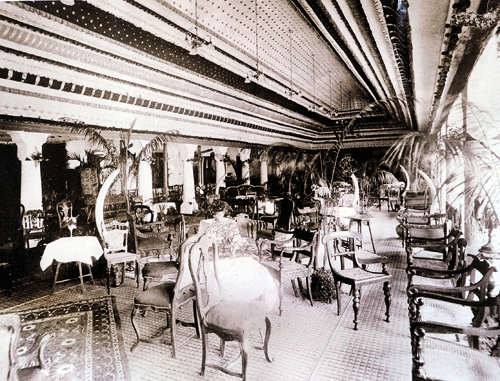
Magul Maduwa of Violet de Soysa
Regina Walauwa was completed between 1911 and 1912 and during its construction, Arthur and Regina with their five children- Violet, Lillian, Pansy, Colvin and Neville occupied ‘Brodie House’ along Galle Road. “The present Majestic City complex is built on these premises and the adjacent Arthur’s Lane is a living memory of my grandfather,” recollects L.S.D. Pieris, son of Violet de Soysa (later Pieris)- the eldest daughter of Arthur and Regina. (Mr. Pieris is the father of Prof. Anoma Pieris). ‘Brodie House’ was not only filled with the laughter of five children but also housed the mammoth wedding cake structure Regina brought back with her after her wedding festivities in Galle. For her children, the structure was a play house, they would run in and out of the cake frames!
While the best of carpenters from Moratuwa were busy transforming Burma teak to resplendent woodwork at Regina Walauwa and intricate floral designs were blossoming on the ceilings and stairways, tragedy struck the young family. Just a year before the completion of the mansion, death knocked on the doors of the 28-year-old mother of five. “My grandmother had to undergo a surgery in the gallbladder and she died of haemorrhage in November, 1910. My mother was just eight years old,” recollects Lilamani Goonewardene, daughter of Lillian de Soysa (the second daughter of Regina and Arthur) and H.A.J Hulugalle- the celebrated Editor and diplomat. “My mother, Lillian had been the naughty one, so much so, grandma Regina had asked her to be on her best behaviour in her absence. Sadly she never survived the surgery.” A portrait of her mother Lillian as a three-year-old toddler at the Brodie House, greets a visitor at Mrs. Goonewardene’s Colpetty residence.
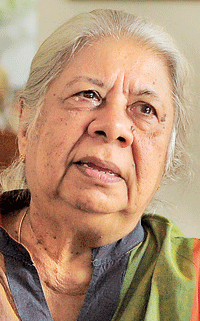
Lilamani Goonewardene: Grand daughter of Arthur and Regina
The hearse carrying the coffin of Regina was driven along the driveway and through the porch of the incomplete residence. The mansion which was mourning the loss of its lady who never trod its imported tiled-floors or held its intricately carved banisters, came alive seven years later when Regina’s eldest daughter Violet was given in marriage to L.E.O. Pieris at a flamboyant wedding reception on September 27th, 1917. The magul maduwa, was in Hindu architectural style, designed by craftsmen from Jaffna. A paper cutting dating back to 1917, which Mr. Pieris, shares with us, titled ‘Marriage of the Chilean consul’s daughter’, records that the bride ‘was attired in a handsome oriental saree of white crepe de chine beautifully embroidered with silver. The saree was turned out by Messrs. Dayaram Brothers, the well-known Bombay merchants of the Fort’.
Meanwhile by the mid-1900s colonial Ceylon was navigating a series of reforms. In 1912, a sub-committee of the Legislative Council of Ceylon tabled for a university to be set up in a new building, originally meant for Royal College. As ‘University of education in Sri Lanka- some aspects’, by Prof. M.B. Ariyapala and Prof. B.E. Bastiampillai (Journal of the Royal Asiatic Society of SL, Volume xxxii) notes, with the intervention of World War 11, the plans were delayed and it was only in 1921 that ‘some action was taken in this direction.’ The Ceylon University College was formally opened in January 1921 housed in none other than Regina Walauwa which Arthur de Soysa sold to the Government of Ceylon in 1920. It was renamed ‘College House’ on the recommendation of Sir Edward Denham. In 1942, University College was elevated to the University of Ceylon. Today College House serves as the administrative centre of the University of Colombo. It is also a heritage site.
Arthur de Soysa, returned to his ancestral home in Moratuwa with his unmarried children after the sale of Regina Walauwa and lived there till his death in 1929 at the age of 55.“My mother Lillian married in 1926 and although her memories of grandmother Regina had not been many, she remembered her as a gracious and gentle lady, and also a gifted seamstress- traits my mother too inherited. She had a magnanimous heart,” smiles Mrs. Goonewardene.
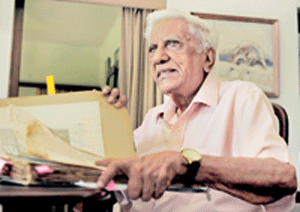
L.S.D. Peiris: Grandson of Arthur and Regina dips into paper cuttings from the past. Pix by Amila Gamage
‘College House’ became an institute of learning to many of Regina’s and Arthur’s descendants. Some continue to enrich the seat of higher education it has become today. Mr. Pieris who entered its portals in the mid-1940s, recollects being accompanied by his mother Violet. “I remember having a cup of tea with my mother in the University café, which she identified to be the kitchen of her then home Regina Walauwa,” smiles Mr. Pieris. Lillian, as her daughter recollects, never spoke of their ‘Regina Walauwa’ days. “Although my mother used to remark once when we visited Italy with our father, that her ancestral home had Italian chandeliers, she never indulged in its glory. History never weighed too heavy on her shoulders. Even my aunts- Violet and Pansy, had adapted to the change well and they moved with the times,” Lilamani Goonewardene adds with a smile.
Being the cradle of university education in the country, Regina Walauwa of yesteryear continues to add regal splendour to the city of Colombo, with its fountains still spurting waters and the flag staff of its former master still standing tall. The flag staff, as Mr. Pieris explains, used to hoist the Chilean flag in honour of the Chilean consul’s office Arthur de Soysa held.


